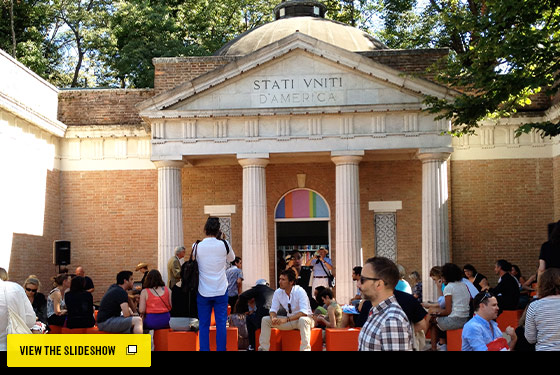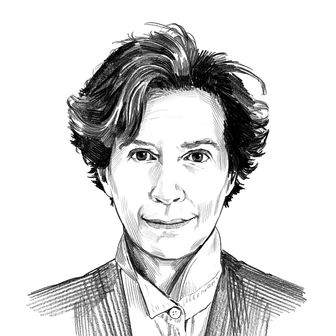

I just got back from Venice, where I went on a whirlwind design-hunting mission at the International Architecture Biennale. It was my first time at the event, and I spent two precious days absorbing the projects in the historic Arsenale and the nearby Giardini. The Arsenale is an industrial complex of buildings where ships were made as early as the twelfth century. The Giardini is filled with pavilions that were constructed beginning in the early-twentieth century. This year’s Biennale curator was British architect David Chipperfield, and the theme was “Common Ground.” The spirit of his vision was encapsulated in the American pavilion, shown here. Note the rainbow-flag colors above the front entrance. Photo: Wendy Goodman

The informal seating outside the Danish pavilion made it easy for Biennale-goers to mingle. Photo: Wendy Goodman

The elegant Nordic pavilion, designed by Sverre Fehn, was my favorite building in the Giardini. The giant tree must have been tiny when the pavilion was built in the late sixties. Photo: Wendy Goodman

Inside the Nordic pavilion: “Light Houses: On the Nordic Common Ground” featured conceptual houses by 32 architects from Finland, Sweden, and Norway who were all born after 1962. Photo: Wendy Goodman

The classical design of the Russian pavilion doesn’t reveal the hypermodern installation contained within. Photo: Wendy Goodman

Welcome to the future! Visitors to the Russian quarter were issued iPads for scanning wall-to-wall QR code that revealed information about an initiative to create a Silicon Valley”style city near Moscow. Photo: Wendy Goodman

A peak at the empty Arsenale before it was filled with Biennale projects. Doesn’t this give you a sense of the scope of the magnificent buildings? Photo: Courtesy of the Venice Architecture Biennale

Another view of the barren Arsenale. The grandeur of the industrial design is so beautiful. Photo: Courtesy of the Venice Architecture Biennale

Australian-based Indian architect Anupama Kundoo built a facsimile of a building she designed in Auroville, India. In a literal act of crosscultural exchange, she brought Indian craftsmen and representatives from the University of Queensland to construct this model alongside aspiring Venetian architects. Photo: Wendy Goodman

The materials used for the roof of Kundoo’s project in India. Photo: Courtesy of the Venice Architecture Biennale

The materials were reinterpreted for Kundoo’s Venice installation using plastic cups. Photo: Wendy Goodman

Zaha Hadid’s installation, “Arum,” is one of the Biennale’s most obvious examples of “starchitecture.” She made the structure with pleated aluminum and displayed it alongside researched documentation illustrating the work of pioneers like Frei Otto and Heinz Isler”a careful nod to their influence. Photo: Wendy Goodman

I found the most moving example of the Biennale’s theme at the Japan pavilion, where Toyo Ito showed models for a project he initiated in the town of Rikuzentakata, which was completely destroyed by the 2011 tsunami. The exhibit showcased the work of three architects: Kumiko Inui, Sou Fujimoto and Akihisa Hirata who joined Ito to design and build homes for people in the town. The delicate structures appeared against walls plastered with photographs of the devastation; a sound-system played the noise of hammers and tools used during the rebuilding process. Photo: Courtesy of Naoya Hatakeyama

